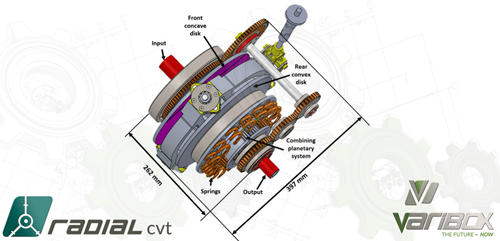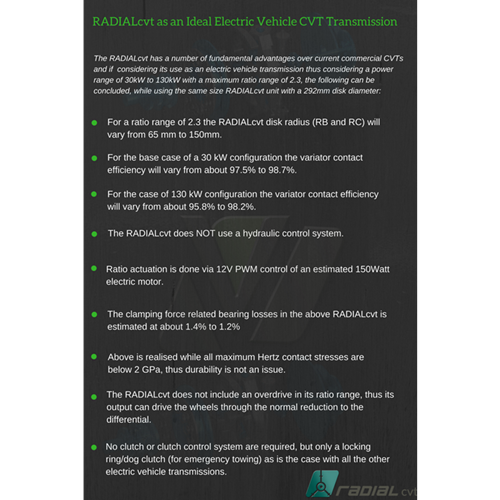RADIALcvt to set Benchmark for Auto Transmission Efficiency

The global auto industry is currently enjoying an astonishing upsurge in continuously variable transmission (CVT) production which is mainly driven by auto makers’ quest to lower carbon emissions, improve driver comfort and hybrid integration. The current issue of Transmission Technology Magazine sheds some insightful developments regarding electric vehicle and traditional transmissions. In 2016, global CVT production reached 12 million units and the figure is expected to surpass the 18 million-mark by 2020.
With autonomous vehicles quickly coming to the fore, CVT has major advantages for autonomous driving because of its smooth behaviour.
Added to that, a good number of electric vehicle (EV) brands are likely to adopt CVT’s as they seek to leverage the technology’s efficiency. Rob Oliver, chief engineer at Drive System Design (DSD), the UK-based transmission systems consultancy predicts that to achieve motor efficiency, “Some (EVs) will use multispeed transmissions or a CVT,” and emphasises that, “Shifting between ratios will have to be imperceptible to the vehicle occupants as sudden interruption and reinstatement of drive torque will be unacceptable.”
A rush for CVT innovation definitely is on, which raises a significant question around the value provided by various innovations.
When it comes to the success of CVT technology, mechanical efficiency, scalability and cost factors are definitely significant defining factors. Dr Jürgen Greiner, head of development for passenger car transmissions for ZF Friedrichshafen AG notes that “Efficiency is the biggest driver of development … it makes sense to use transmissions with higher transmission-ratio spreads, and more gears with smaller gear steps, to reduce fuel consumption.”
We take a brief look at some of the new CVT’s on the market and the RADIALcvt from Varibox and explain how the RADIALcvt innovation leads the pack because of its mechanical efficiency.
GKN Multispeed eAxle
The two speed eAxle proved that a 100 kW direct drive e-motor can be replaced by a 80 kW e-motor integrated with a two speed transmission. Moreover, the 80 kW eAxle is 28% lighter than the 100kW e-motor and boasts a 36% improvement in 0 to 50km/h acceleration as well as a 22% improvement in acceleration of 0-100km/h. The 80kW e-motor was also, 28% lighter and 20% smaller than the 100kW system.
Dana Variglide
In Dana’s Variglide, full ratio from underdrive to overdrive can be achieved in 0.2 seconds and torque mode shifts cannot be perceptible meaning there is no sudden interruption and reinstatement of drive. This allows for the development of shift characteristics from smooth cruising to sport modes. The Variglide has higher launch torques and functions without the need for a CVT high pressure pump.
Voices
Voices uses two small motors, each coupled to a 2 speed transmission patented system which provides a seamless shift design.
Bosch Single Loopset Belt
Bosch transmission technology is about to introduce the Single Loopset Belt (SLB) an improved version of its earlier pushbelt designs. Bosch also intend to replace the current hydraulic clamping with electric clamping in their CVT’s. The innovation according to Bosch Transmission Technology vice-president Han-Hein Spit, is suited for autonomous driving, hybrid drivetrains and full electric vehicles. In 2016, Bosch celebrated producing its 50 millionth pushbelt, a figure which goes a long way in demonstrating the company’s dominance over the industry. The company’s largest markets are the USA, EU, China, South Korea and Japan. Bosch is about to introduce its reinvented.
Varibox CVT Technologies’ RADIALcvt
The RADIALcvt is a cost effective CVT solution which uses very well-developed traction friction drive technology from Varibox CVT Technologies and is especially applicable in electric vehicles as well as all traditional CVT applications.. Its features include:
- One friction interface which prevents compound friction loss
- Six parallel paths: The RADIALcvt has at least 6 parallel power paths. Such large power paths are only possible in planet ball CVT’s
- A large output friction disk which allows the RADIALcvt to provide its highest efficiency in low ratios associated with city driving.
- No hydraulic control system: The RADIALcvt, unlike all the other CVTs does not have any hydraulic control.
- Low bearing losses: Disc bearing (clamping force) losses, which are a well-known source of traction drive CVT losses varies between 1.5% and 2.5% of transmitted power.
- Clamping force utilisation and location: In the RADIALcvt a unit of clamping force supports two parallel friction drive interfaces. The RADIALcvt clamping force, bearing losses are only associated with the RADIALcvt output, namely the Convex and Concave disks, while the RADIALcvt input, the radial drivers, are in equilibrium. Thus, these bearing losses, for a given clamping force, are only a function of the RADIALcvt output speed. This has the obvious low loss advantages in low output speed ratios.
RADIALcvt E2 Configuration
The RADIALcvt can be modified to serve as an E2 transmission. To learn more about the RADIALcvt E2 configuration in detail, please click here.
The RADIALcvt as an electric transmission:
Varibox’s RADIALcvt can serve as a perfect transmission in electric vehicles.

The technology used for the RADIALcvt components is new, unique and fully patented, which allows it to be easily evaluated by potential licensees. To learn more about the RADIALcvt, please download the RADIALcvt simulation document here.
To learn more about the RADIALcvt as an ideal electric vehicle transmission download the RADIALcvt electric vehicle document here.
Should you have any further inquiries, please send an email to jnaude@varibox.com


